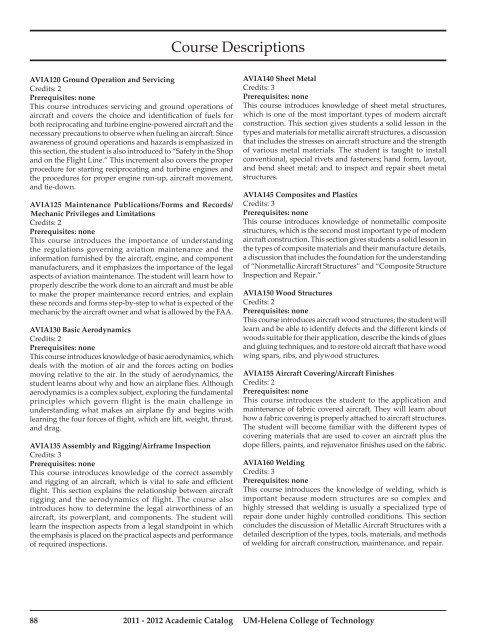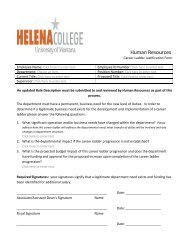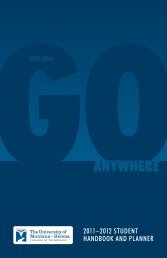2011 - 2012 Student Calendar - Helena College of Technology
2011 - 2012 Student Calendar - Helena College of Technology
2011 - 2012 Student Calendar - Helena College of Technology
- No tags were found...
You also want an ePaper? Increase the reach of your titles
YUMPU automatically turns print PDFs into web optimized ePapers that Google loves.
Course DescriptionsAVIA120 Ground Operation and ServicingCredits: 2Prerequisites: noneThis course introduces servicing and ground operations <strong>of</strong>aircraft and covers the choice and identification <strong>of</strong> fuels forboth reciprocating and turbine engine-powered aircraft and thenecessary precautions to observe when fueling an aircraft. Sinceawareness <strong>of</strong> ground operations and hazards is emphasized inthis section, the student is also introduced to “Safety in the Shopand on the Flight Line.” This increment also covers the properprocedure for starting reciprocating and turbine engines andthe procedures for proper engine run-up, aircraft movement,and tie-down.AVIA125 Maintenance Publications/Forms and Records/Mechanic Privileges and LimitationsCredits: 2Prerequisites: noneThis course introduces the importance <strong>of</strong> understandingthe regulations governing aviation maintenance and theinformation furnished by the aircraft, engine, and componentmanufacturers, and it emphasizes the importance <strong>of</strong> the legalaspects <strong>of</strong> aviation maintenance. The student will learn how toproperly describe the work done to an aircraft and must be ableto make the proper maintenance record entries, and explainthese records and forms step-by-step to what is expected <strong>of</strong> themechanic by the aircraft owner and what is allowed by the FAA.AVIA130 Basic AerodynamicsCredits: 2Prerequisites: noneThis course introduces knowledge <strong>of</strong> basic aerodynamics, whichdeals with the motion <strong>of</strong> air and the forces acting on bodiesmoving relative to the air. In the study <strong>of</strong> aerodynamics, thestudent learns about why and how an airplane flies. Althoughaerodynamics is a complex subject, exploring the fundamentalprinciples which govern flight is the main challenge inunderstanding what makes an airplane fly and begins withlearning the four forces <strong>of</strong> flight, which are lift, weight, thrust,and drag.AVIA135 Assembly and Rigging/Airframe InspectionCredits: 3Prerequisites: noneThis course introduces knowledge <strong>of</strong> the correct assemblyand rigging <strong>of</strong> an aircraft, which is vital to safe and efficientflight. This section explains the relationship between aircraftrigging and the aerodynamics <strong>of</strong> flight. The course alsointroduces how to determine the legal airworthiness <strong>of</strong> anaircraft, its powerplant, and components. The student willlearn the inspection aspects from a legal standpoint in whichthe emphasis is placed on the practical aspects and performance<strong>of</strong> required inspections.AVIA140 Sheet MetalCredits: 3Prerequisites: noneThis course introduces knowledge <strong>of</strong> sheet metal structures,which is one <strong>of</strong> the most important types <strong>of</strong> modern aircraftconstruction. This section gives students a solid lesson in thetypes and materials for metallic aircraft structures, a discussionthat includes the stresses on aircraft structure and the strength<strong>of</strong> various metal materials. The student is taught to installconventional, special rivets and fasteners; hand form, layout,and bend sheet metal; and to inspect and repair sheet metalstructures.AVIA145 Composites and PlasticsCredits: 3Prerequisites: noneThis course introduces knowledge <strong>of</strong> nonmetallic compositestructures, which is the second most important type <strong>of</strong> modernaircraft construction. This section gives students a solid lesson inthe types <strong>of</strong> composite materials and their manufacture details,a discussion that includes the foundation for the understanding<strong>of</strong> “Nonmetallic Aircraft Structures” and “Composite StructureInspection and Repair.”AVIA150 Wood StructuresCredits: 2Prerequisites: noneThis course introduces aircraft wood structures; the student willlearn and be able to identify defects and the different kinds <strong>of</strong>woods suitable for their application, describe the kinds <strong>of</strong> gluesand gluing techniques, and to restore old aircraft that have woodwing spars, ribs, and plywood structures.AVIA155 Aircraft Covering/Aircraft FinishesCredits: 2Prerequisites: noneThis course introduces the student to the application andmaintenance <strong>of</strong> fabric covered aircraft. They will learn abouthow a fabric covering is properly attached to aircraft structures.The student will become familiar with the different types <strong>of</strong>covering materials that are used to cover an aircraft plus thedope fillers, paints, and rejuvenator finishes used on the fabric.AVIA160 WeldingCredits: 3Prerequisites: noneThis course introduces the knowledge <strong>of</strong> welding, which isimportant because modern structures are so complex andhighly stressed that welding is usually a specialized type <strong>of</strong>repair done under highly controlled conditions. This sectionconcludes the discussion <strong>of</strong> Metallic Aircraft Structures with adetailed description <strong>of</strong> the types, tools, materials, and methods<strong>of</strong> welding for aircraft construction, maintenance, and repair.88 <strong>2011</strong> - <strong>2012</strong> Academic Catalog UM-<strong>Helena</strong> <strong>College</strong> <strong>of</strong> <strong>Technology</strong>




